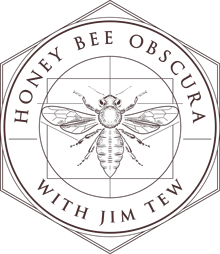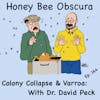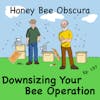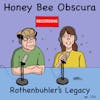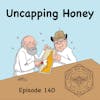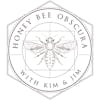In Class with Jim: "Supering" (163)

In this episode we delve into the concept of "supering," a term unique to beekeeping that has emerged over the past century. To those outside the beekeeping community, the term might sound like something out of a superhero comic, but for beekeepers,...
In this episode we delve into the concept of "supering," a term unique to beekeeping that has emerged over the past century. To those outside the beekeeping community, the term might sound like something out of a superhero comic, but for beekeepers, it's a crucial aspect of hive management.
Jim, guides listeners through the history and significance of supering in beekeeping. But what exactly is supering? It involves adding boxes, known as supers or honey supers, to the hive. These are designed for bees to store surplus honey, which beekeepers later harvest at season's end.
Supering strategies vary, and while many techniques exist, Jim emphasizes the importance of understanding and adhering to established best management practices for honey collection and super removal. He provides insights on the optimal timing for adding and removing honey supers, a key to successful beekeeping.
Join us in this class on supering with Jim, and gain valuable knowledge on this essential beekeeping practice. Tune in to enhance your understanding and skills in managing your hives.
______________________
Thanks to Betterbee for sponsoring today's episode. Betterbee’s mission is to support every beekeeper with excellent customer service, continued education and quality equipment. From their colorful and informative catalog to their support of beekeeper educational activities, including this podcast series, Betterbee truly is Beekeepers Serving Beekeepers. See for yourself at www.betterbee.com
______________________
Honey Bee Obscura is brought to you by Growing Planet Media, LLC, the home of Beekeeping Today Podcast.
Music: Heart & Soul by Gyom, All We Know by Midway Music; Christmas Avenue by Immersive Music; original guitar music by Jeffrey Ott
Cartoons by: John Martin (Beezwax Comics)
Copyright © 2024 by Growing Planet Media, LLC

Episode 163 – In Class with Jim: "Supering"
Jim Tew: Honeybee Obscura podcast listeners, what a strange topic I have on my mind today, as the snow comes down, wind blows, concerned about the salt trucks getting here or not to fix the roads. It could not be any more winter in essentially all of the continental US. Yet for the last few days in preparation for this discussion, I've had the concept and the subject of supering on my mind. Even though the season is wrong and even though there's nowhere right now in the continental US where supering is an issue, in just a few months it will be.
I'd like to spend a few minutes talking to you about supering and why and when. I'm Jim Tew, here at Honeybee Obscura podcast, where once a week, every Thursday morning, we talk about something about beekeeping. What I'd like to spend some time on today is the concept of supers and the timing of supering.
Introduction: Welcome to Honeybee Obscura, brought to you by Growing Planet Media, the producers of the Beekeeping Today podcast. Join Jim Tew, your guide through the complexities, the beauty, the fun, and the challenges of managing honeybees. Jim hosts fun and interesting guests who take a deep dive into the intricate world of honeybees. Whether you're a seasoned beekeeper or just getting started, get ready for some plain talk that'll delve into all things honeybees.
Jim: Listeners, I've tried multiple times to think how to put this into a sequence that is digestible in a podcast format. Let me try it this way. Looking at your beekeeping life, looking at your beekeeping experiences right here, right now, just like a snapshot. If you look at this same snapshot that you made last year or 10 years or 50 years ago, how different that picture would look. Beekeeping always moves along. Beekeeping always evolves. Beekeeping always changes. Beekeeping today does not look exactly like beekeeping 50 years ago.
Where's all this going? We have this concept of supering. Probably at small talk and sitting around meetings and talking with beekeeping friends, you come up and somebody will always ask what an odd word that is, and certainly every beekeeper known to humankind has had to spend some time explaining to non-beekeepers what this super is. It's actually a box. I just despise it when someone goes to the dictionary and reads a definition, but I'm almost reduced to doing that. If you look up supering, it basically is a prefix meaning over or above or on top of, and then beyond that, what followed, listeners, was hundreds and hundreds of words with the word super as a prefix beginning those words.
It's a common word. The fifth definition that Merriam-Webster offered was the top part of a beehive. Somehow we took this prefix and turned it into, I guess it'd be a noun that we describe as a box, a surplus box that goes on top of a beehive because a super means over, above, or in excess of. We're still using an old definition of a word now that is extremely popular in our vocabulary with multiple, multiple uses of the word super or parts of the word super.
Here's the oddity, here's the snapshot thing I was telling you about. It wasn't always that way. It was only just a few years ago that-- well, a few years ago in relative terms, that just putting a box on top of the hive was not the only option. In our earliest days of managed beekeeping and removable frame boxes, you could put the box on top, the surplus box, it may have been a glass dome, but this was pre-Langstroth hive, and if you put it on top of the hive, yes, it was called a super. There were systems of the day that wanted you to put the extra equipment on the bottom of the hive or beneath the skep or beneath the box, and that was called nadiring.
There were other systems that wanted you to put the surplus equipment on either side of the brood nest or on both sides. In a sense, it was a lateral hive with a nest in the middle, and then on either side of that nest, extra equipment was added, and that was called collateral hives. You could either super, you could nadir, or you could use collateral boxes for storage. You didn't have to only go with our concept of supering. Then just to make things confusing enough, you could also eke, E-K-E, eke a hive.
When you eked a hive, you added a rim. It'd be nothing more, you'd call it a spacer rim or other common names for these simple rims that are used just to give you more space under a super or under an outer cover or under an inner cover, wherever you want more space for queen cages or sugar patties or whatever. The earliest days when they would do that underneath skeps, it was called eking. I want you to know that it seems to me, listeners, and this is not a historical documentation, this is me guessing, that as Langstroth grew and developed in popularity and was able to convince beekeepers of the day that his hive was the best design, his particular hive was one that was supered.
It wasn't nadired, it wasn't a collateral hive, and it was not generally eked. I suspect, without any historical documentation, that the popularity and the acceptance of the Langstroth hive and the concept of supering that it brought with it was the reason that these other styles, other techniques, went away. It looks to you, like to you and me, that this concept of supering has always been here, always will be here, but no, it's only been here for about 100 to 150, 160 years or so, and the Warre hive has done a good job of bringing back nadiring.
The Warre hive essentially does super beneath the brood nest or add extra equipment beneath the brood nest as the colony grows because the concept is the colony tends to grow downward. This whole concept of making it move upward, some argue, is a beekeeper artifact that we've worked on. There it is, for the most part. If you go out and super your beehive, it's because you chose to super, you chose not to nadir or to do the collateral procedure, and you didn't add a rim that you would have called an eke. You supered. That term just remains there.
Very quickly, I'd like to say that sometimes you hear the term undersupering. That just adds to the confusion because undersupering could mean that you put a super under the full box on top of your colony, or undersupering could mean that you didn't put enough equipment on the hive at all, resulting in part of the honey crop being lost. That undersupering concept does not have a clear definition at this part, and that's just to offer that to add to the whole confusion and the disruption of everything. There it is. I wanted to go back into that.
Then I'm going to spend some other time and other sessions with this because beekeeping is just fraught with these artifacts that remain, that sit there years and years later after society has passed along, and this concept of supering is just one of those. What I'd like to do is take a break, hear from our sponsors, and then I want to come back and talk more about when and how to super.
Betterbee: Now that your bees are cozy for the winter, let's turn up the heat with Better Bees Mind-Blowing Classes. Led by the brilliant Dr. David Peck and the fantastic EAS Master Beekeeper Anne Frey, these classes cover everything from beekeeping basics to advanced winter wisdom. Whether you're a winter beekeeping beginner or a seasoned pro in the apiary, our classes cover everything from snowy basics to advanced insights for winter beekeeping. Head over to betterbee.com/classes and unlock the secrets to upping your beekeeping game because at Better Bee, we're all about keeping you warm with knowledge all winter long.
Jim: Okay, listeners, we're back. After we've decided that supering is the thing for us to do, we add our equipment to the top. After the snow and the season is all gone, but be patient, it's not that far until you begin to see the first spring blooms coming in many parts of the country, it's time to begin the process of giving the bees extra space. You see that's us, beekeepers. We want the extra space. We want to encourage honey production. We want to, in any way we can, discourage swarming. Both of those options are really not normal in the natural bee world.
A bee colony wants to make as much honey as it can and swarm as often as it can in the wild. That just drives beekeepers crazy because every time they swarm, honey crop flies away. Your valuable queen flies away. We don't want that to happen. We begin to super in early spring. This is not meant to be a management discussion. This is strictly on supering. In early spring, when the other spring chores have been done, we begin to add supers on top of the hive, probably about the time that our earliest sources of nectar and pollen come in. That's probably going to be, in many cases, tree pollens and tree nectar. At least it is here in the Midwest, but I cannot speak for the country.
In the early part, then we begin to add supers and we expect there to be a rise and fall, and then the sky's the limit. How many supers do you have, beekeepers? Do you have plenty? Are you going to build more or are you really short on equipment? You've got too many hives or whatever? You put the box on and take the box off as soon as it's full and then put it back on like an old drink bottle being refilled. You may decide to use a little equipment a lot, or you may have plenty of extra equipment and just keep stacking these boxes on, ergo the undersupering, oversupering discussion we had just before the break.
In the early part of the season, you really want to consider oversupering because at that point, the space isn't really going to hurt. Now, don't go crazy, listeners. Don't put three and four and five empty deeps on unless you really know that a major flow is coming. For most of us, putting on one or two empty supers at the time in the early part of the season would be a gracious plenty, an optimistic plenty. I guess I can word it that way. Then as the season progresses, then oddly, somewhere around the middle of the season, for me here is going to be June, as June turns into July, the days get particularly hot. The grass begins to die out on the lawn and the septic field begins to show up.
Those are all signs that my primary nectar season for the year has begun to pass. It's not totally over, and there may be little hits here and there that come along. For the most part, after late June here where I am, I'm beginning to wind down. Listeners, at that point, don't put on more empty equipment. I want the bees to finish capping what they've done on those residual supers that I've got on. Early season, oversuper, late season, undersuper. The cues that I'm looking for in the early season are always exciting. No matter how long you keep bees, it's always exciting to see clear signs that the bees are bringing in nectar. No better way to do that than a hive scale of some kind.
There's some really nice modern hive scales out there where you can sit in your house while you're watching television and monitor weight gains on your colony. That's intriguing. Have some of that if you want to. When the concept or the process of what beekeepers call whiting, sometimes called icing, when bees are coming back and they're just chock-a-block full of nectar, they're like tankers. They have to sit there stored, holding that nectar until they can find a cell to put it in or a house bee to give it to. It seems that if over time they're unable to find a house bee to give that load to, they have to sit there and hold it.
It has been speculated that while they are holding that nectar, their wax glands begin to function because there's a need for storage area because this bee can't get rid of the load that it's brought back. They'll begin to produce wax and from that, hypothetically build new comb. At the risk of getting into the management concept of this discussion, they'll begin to pack out the brood nest at the expense of the colony's growth and begin to fill the brood nest with nectar because they have no place else to put it. Now in the natural scheme of things, they would have swarmed. This is not the natural scheme of things for bees because we have beekeepers involved in this, adding supers and trying to restrict swarming.
When I see whiting, W-H-I-T-I-N-G, then I know that there's an active nectar season going on and that surplus nectar is coming in. As the bees rummage around the colony and they have these wax scales that hang off the eight ventral glands of wax gland production on the ventral surface, those wax flakes rub across edges and corners of everything, and they leave a faint coating of new wax on the edges of frames, on the edges of burr combs, on the new combs, on the combs themselves can have some of this fine, white, small edge of pure white on it. It'll stand out when you get a chance to see it.
That's the cue that the season is well underway and you really want to be supering at that point because that's going to be, in most cases, your biggest hit that goes along there. When this whiting is undergoing, tend to oversuper. Once whiting has passed and this whiting or icing has subsided, either you've got enough equipment on, and from that point on you want to tend to undersuper so that you don't miss part of the honey crop.
What happens then, real quickly, because I've really tried to stay out of getting involved in the management discussion of this colony throughout this time, but what do you do if the season now is winding down and there's still unkempt honey? There's still, well, we call it green honey, not because of the color but because it's not ripe, it's not capped, it's not finished. Once the bees lose the ability to produce wax, then they stop capping. They don't go eat honey that they've stored to produce cappings, to put cappings over the honey that's remaining there unkempt. That wouldn't be efficient.
What can you do then if you're left season's ending, and you tried to undersuper like Jim told you to? Still didn't work. You've got what you think to be too much unkempt honey, then at that point, you would feed just as thick a syrup as you can make to simulate enough of a flow to provide the bees with the food that they need to generate wax cappings to finish capping that off. I just have to say it, then you're going to get the comments, well, then you're making sugar honey. No, you're really not because just as soon as that capping is done and you take those supers off, then this whole feeding process stops, so you're only feeding enough of that to get them to produce the wax cappings to finish that up.
Bottom line, once you see in your area, based on the calendar, based on your experience, based on your conversations with your mentors or other beekeepers, that the early season is starting up, then get that equipment on before the bees bind themselves up, before they get crowded, before they get swarming. As you approach the middle of the season, stop doing that. From the middle of the season to the end of the nectar flow, tend to undersuper, so the bees will finish whatever supers, whatever combs they've started, and finish taking the moisture out and then capping that all off so that you've got nice full frames to take off.
You see all this because it's a wintry, snowy day here, and I really would like to have a spring fever here or something. I'm ready to go now. I'm ready for spring. This was a topic for me, probably as much as you. I enjoyed talking about nadiring and collateral hives and supering and whiting and icing and the whole thing. I hope you are enjoying this enough to in some way be prepared for the next spring season. That's all I got, listeners. Jim telling you bye until next week.
[00:21:25] [END OF AUDIO]
New to Honey Bee Obscura Podcast?
Here are some great episodes to start with. Or, check out episodes by topic.







 In this episode we delve into the concept of "supering," a term unique to beekeeping that has emerged over the past century. To those outside the beekeeping community, the term might sound like something out of a superhero comic, but for beekeepers, it's a crucial aspect of hive management.
In this episode we delve into the concept of "supering," a term unique to beekeeping that has emerged over the past century. To those outside the beekeeping community, the term might sound like something out of a superhero comic, but for beekeepers, it's a crucial aspect of hive management.
